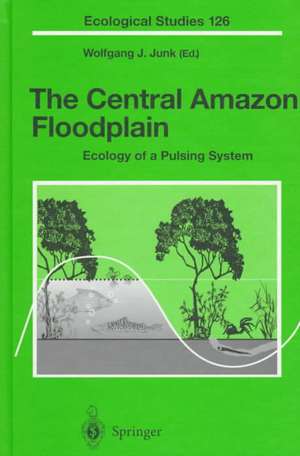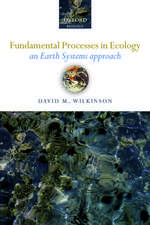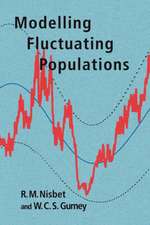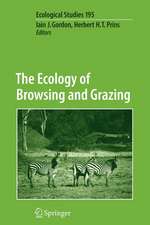The Central Amazon Floodplain: Ecology of a Pulsing System: Ecological Studies, cartea 126
Editat de Wolfgang J. Junken Limba Engleză Hardback – 5 iun 1997
This book presents the results of a 15-year study of the structure and function of one of the largest tropical floodplains, the Amazon River floodplain. It covers qualitative aspects, e.g., adaptations of aquatic and terrestrial organisms to the flood pulse as well as quantitative aspects, e.g., studies of biomass, primary production, decomposition, and nutrient cycles. The authors interpret their findings and the most important data from other studies under an integrating scientific concept, the Flood Pulse Concept.
| Toate formatele și edițiile | Preț | Express |
|---|---|---|
| Paperback (1) | 1828.11 lei 6-8 săpt. | |
| Springer Berlin, Heidelberg – dec 2010 | 1828.11 lei 6-8 săpt. | |
| Hardback (1) | 1834.27 lei 6-8 săpt. | |
| Springer Berlin, Heidelberg – 5 iun 1997 | 1834.27 lei 6-8 săpt. |
Din seria Ecological Studies
- 18%
 Preț: 1118.93 lei
Preț: 1118.93 lei -
 Preț: 553.71 lei
Preț: 553.71 lei - 18%
 Preț: 1680.55 lei
Preț: 1680.55 lei - 18%
 Preț: 1003.38 lei
Preț: 1003.38 lei - 20%
 Preț: 1004.69 lei
Preț: 1004.69 lei -
 Preț: 480.62 lei
Preț: 480.62 lei - 5%
 Preț: 752.26 lei
Preț: 752.26 lei - 15%
 Preț: 643.99 lei
Preț: 643.99 lei - 15%
 Preț: 644.18 lei
Preț: 644.18 lei - 15%
 Preț: 652.49 lei
Preț: 652.49 lei - 18%
 Preț: 789.83 lei
Preț: 789.83 lei -
 Preț: 382.36 lei
Preț: 382.36 lei - 15%
 Preț: 643.48 lei
Preț: 643.48 lei - 15%
 Preț: 646.30 lei
Preț: 646.30 lei - 15%
 Preț: 634.32 lei
Preț: 634.32 lei -
 Preț: 384.86 lei
Preț: 384.86 lei - 18%
 Preț: 789.98 lei
Preț: 789.98 lei - 15%
 Preț: 645.14 lei
Preț: 645.14 lei - 15%
 Preț: 649.39 lei
Preț: 649.39 lei - 18%
 Preț: 1005.43 lei
Preț: 1005.43 lei - 18%
 Preț: 949.23 lei
Preț: 949.23 lei - 15%
 Preț: 649.54 lei
Preț: 649.54 lei - 15%
 Preț: 643.34 lei
Preț: 643.34 lei - 15%
 Preț: 649.71 lei
Preț: 649.71 lei - 15%
 Preț: 638.76 lei
Preț: 638.76 lei - 18%
 Preț: 957.62 lei
Preț: 957.62 lei - 18%
 Preț: 1235.25 lei
Preț: 1235.25 lei - 18%
 Preț: 962.18 lei
Preț: 962.18 lei - 18%
 Preț: 949.23 lei
Preț: 949.23 lei - 15%
 Preț: 660.68 lei
Preț: 660.68 lei -
 Preț: 397.76 lei
Preț: 397.76 lei - 15%
 Preț: 638.24 lei
Preț: 638.24 lei - 18%
 Preț: 942.31 lei
Preț: 942.31 lei - 18%
 Preț: 1232.57 lei
Preț: 1232.57 lei - 15%
 Preț: 651.34 lei
Preț: 651.34 lei - 18%
 Preț: 952.72 lei
Preț: 952.72 lei - 18%
 Preț: 1229.10 lei
Preț: 1229.10 lei -
 Preț: 423.95 lei
Preț: 423.95 lei - 18%
 Preț: 948.92 lei
Preț: 948.92 lei
Preț: 1834.27 lei
Preț vechi: 2236.91 lei
-18% Nou
Puncte Express: 2751
Preț estimativ în valută:
351.03€ • 366.02$ • 291.74£
351.03€ • 366.02$ • 291.74£
Carte tipărită la comandă
Livrare economică 20 martie-03 aprilie
Preluare comenzi: 021 569.72.76
Specificații
ISBN-13: 9783540592761
ISBN-10: 3540592768
Pagini: 556
Ilustrații: XXIII, 528 p.
Dimensiuni: 156 x 234 x 35 mm
Greutate: 0.95 kg
Ediția:1997
Editura: Springer Berlin, Heidelberg
Colecția Springer
Seria Ecological Studies
Locul publicării:Berlin, Heidelberg, Germany
ISBN-10: 3540592768
Pagini: 556
Ilustrații: XXIII, 528 p.
Dimensiuni: 156 x 234 x 35 mm
Greutate: 0.95 kg
Ediția:1997
Editura: Springer Berlin, Heidelberg
Colecția Springer
Seria Ecological Studies
Locul publicării:Berlin, Heidelberg, Germany
Public țintă
ResearchCuprins
I: Introductory Remarks.- 1 General Aspects of Floodplain Ecology with Special Reference to Amazonian Floodplains.- II: The Physical and Chemical Environment.- 2 The Large Central Amazonian River Floodplains Near Manaus: Geological, Climatological, Hydrological, and Geomorphological Aspects.- 3 Chemistry of Várzea and Igapó Soils and Nutrient Inventory of Their Floodplain Forests.- 4 Physicochemical Conditions in Floodplains.- 5 Modelling Nutrient Fluxes in Floodplain Lakes.- 6 Nitrogen Turnover in the Várzea.- 7 Methane Emissions from the Amazon Floodplain.- III: Plant Life in the Floodplain.- 8 Plant Life in the Floodplain with Special Reference to Herbaceous Plants.- 9 The Chemical Composition, Food Value, and Decomposition of Herbaceous Plants, Leaves, and Leaf Litter of the Floodplain Forests.- 10 Phytoplankton and Periphyton.- 11 The Forest Ecosystem of the Floodplains.- 12 Decomposition of Wood.- IV: Animal Life in the Floodplain.- 13 Aquatic Invertebrates.- 14 Terrestrial Invertebrates: Survival Strategies, Group Spectrum, Dominance and Activity Patterns.- 15 Adaptations to Life Under Water: Tiger Beetles and Millipedes.- 16 The Oribatid Mites.- 17 The Collembola.- 18 The Termites.- 19 The Spider Communities.- 20 The Fish.- 21 Mammals, Reptiles and Amphibians.- 22 The Birds.- V: Conclusions.- 23 Structure and Function of the Large Central Amazonian River Floodplains: Synthesis and Discussion.- References.
Textul de pe ultima copertă
Floodplains are ecosystems which are driven by periodic inundation and oscillation between terrestrial and aquatic phases. An understanding of such pulsing systems is only possible by studying both phases and linking the results into an integrated overview.
This book presents the results of a 15-year study of the structure and function of one of the largest tropical floodplains, the Amazon River floodplain. It covers in 23 chapters hydrology, hydrochemistry, climatology, soil science, and the ecology of various groups of aquatic and terrestrial plants and animals. In the botanical section, emphasis is given to aquatic algae (phytoplankton and periphyton), aquatic macrophytes, terrestrial herbaceous plants and the floodplain forest. The zoological section covers common terrestrial invertebrates (i.e. spiders, collemboles, termites, oribatid mites, tiger beetles, millipedes), aquatic invertebrates (zooplankton, perizoon, benthos), fishes, birds, mammals, amphibians and reptiles. Data are presented on the biomass of plants and animals, on primary production and decomposition of algae, herbaceous plants and trees of the floodplain forest. The amounts of bioelements stored in different compartments of the system during the aquatic and the terrestrial phases are quantified and fluxes between the phases are described.
The authors interpret their findings and the most important data from other studies under an integrating scientific concept, the Flood Pulse Concept.
This book presents the results of a 15-year study of the structure and function of one of the largest tropical floodplains, the Amazon River floodplain. It covers in 23 chapters hydrology, hydrochemistry, climatology, soil science, and the ecology of various groups of aquatic and terrestrial plants and animals. In the botanical section, emphasis is given to aquatic algae (phytoplankton and periphyton), aquatic macrophytes, terrestrial herbaceous plants and the floodplain forest. The zoological section covers common terrestrial invertebrates (i.e. spiders, collemboles, termites, oribatid mites, tiger beetles, millipedes), aquatic invertebrates (zooplankton, perizoon, benthos), fishes, birds, mammals, amphibians and reptiles. Data are presented on the biomass of plants and animals, on primary production and decomposition of algae, herbaceous plants and trees of the floodplain forest. The amounts of bioelements stored in different compartments of the system during the aquatic and the terrestrial phases are quantified and fluxes between the phases are described.
The authors interpret their findings and the most important data from other studies under an integrating scientific concept, the Flood Pulse Concept.















